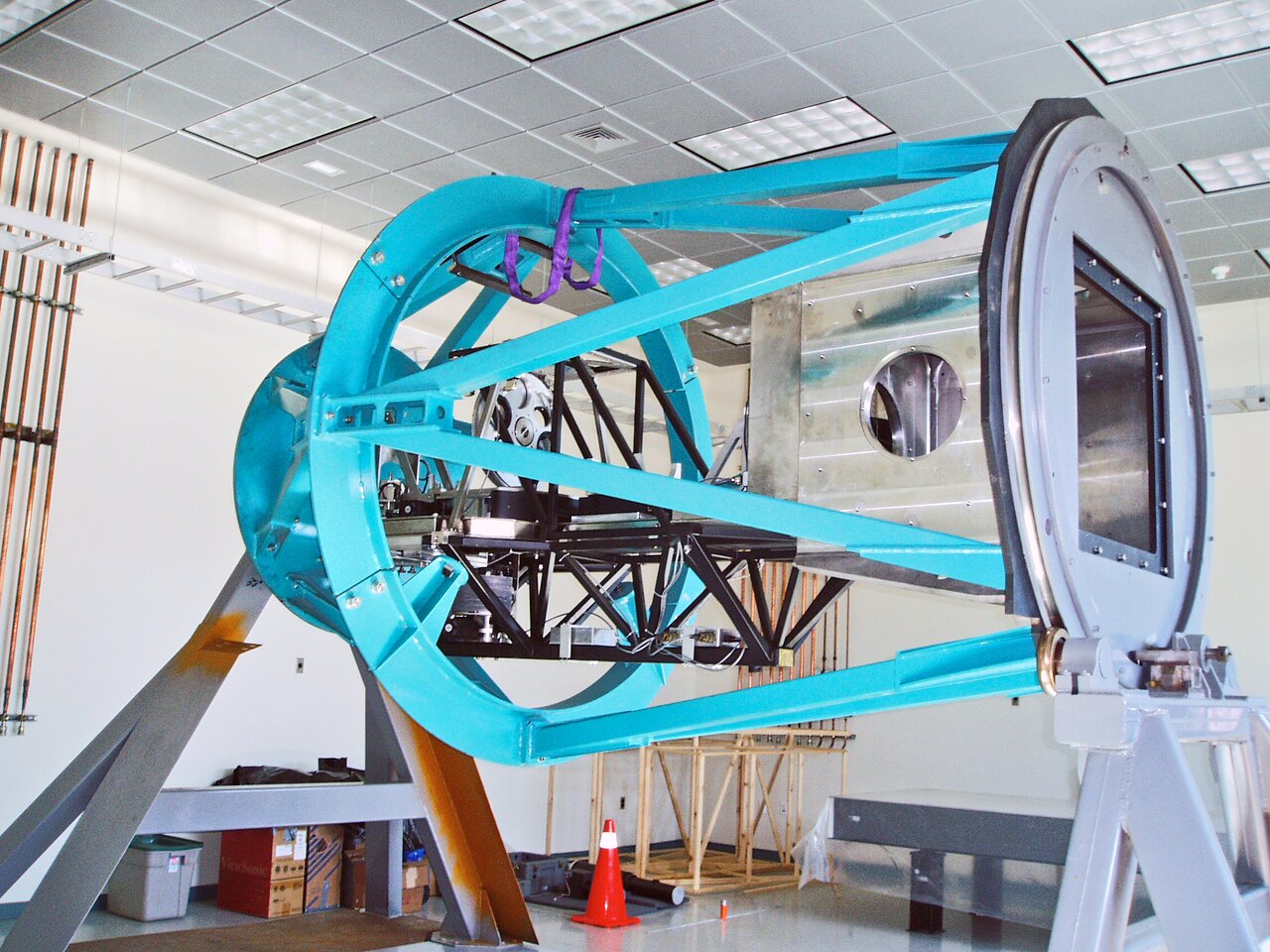Goodman High Throughput Spectrograph (Goodman HTS)

The Goodman Spectrograph and the Nasmyth cage for the SOuthern Astrophysical Research (SOAR) telescope.
The Goodman High Throughput Spectrograph (Goodman HTS) is an imaging, multi-object spectrograph for the SOuthern Astrophysical Research (SOAR) telescope. It is one of the first designed to take advantage of Volume Phase Holographic gratings by employing a movable camera to isolate the desired wavelength range. A Volume Phase Holographic grating is a type of transmission grating. Transmission gratings operate by allowing the light to pass through the grooves etched onto the surface with a constant distance between them. These grooves act to disperse the incoming light into a spectrum.
Goodman was created at the Goodman Laboratory for Astronomical Instrumentation at the University of North Carolina, Chapel Hill. The Goodman spectrograph has a 320–900 nanometer wavelength range, and a scale of 0.15 arcsecond per pixel. It has a circular 7.2-arcminute-diameter field of view in imager mode, and two spectroscopic modes: a long single slit, and a multi-object slit (MOS). The long single slit mode is 0.45 to 10 arcseconds wide and 3.9 arcminutes long, while the MOS mode can take the spectra of multiple objects simultaneously over a 3.0- by 5.0-arcminute rectangular field. Goodman has a carousel-style mask changer that can hold up to 36 masks with interchangeable slit plates of various widths and lengths. A built-in atmospheric dispersion corrector (ADC) is best used for MOS observations, as it is capable of full correction down to elevations of 30 degrees above the horizon.
The spectrograph has two main camera detectors available. The blue camera is optimized for the ultraviolet range down to 320 nanometers, and is used for programs requiring the highest possible throughput blueward of about 450 nanometers. The red camera is optimized for observations redward of 400 nanometers, and is used for all other programs. The response of this camera is roughly equal to that of the blue camera around 450 nanometers, and has negligible fringing out to 950 nanometers. Goodman can additionally have up to three Volume Phase Holographic gratings of 400–2400 lines per millimeter installed at a time, with different blue- or red-optimized options for the 1200 lines per millimeter grating. Blocking filters are used to prevent second-order contamination of blue light, which occurs when taking spectra redward of about 600 nanometers.

The Goodman Spectrograph and the Nasmyth cage for the SOuthern Astrophysical Research (SOAR) telescope.
Science Highlights of Goodman HTS
- SOAR Telescope Catches Dimorphos’s Expanding Comet-like Tail After DART Impact
- Cosmic 'Spider' Found to Be Source of Powerful Gamma-Rays
- Hiding in Plain Sight: Undergraduates Discover the Densest Galaxies Known
Quick Facts
|
|
Goodman HTS The technical information for astronomical observations is available at the NOIRLab Science webpage. |
|
|
Site |
Cerro Pachón |
|
Telescope |
SOAR |
|
Type |
Imager / Spectrograph / Multi-Object Spectrograph (MOS) |
|
Wavelength range |
320–900 nanometers |
|
Spatial resolution: |
0.15 arcsec/pixel |
|
Number of detectors |
2 |
|
Detector format |
4096 x 4096 pixels (blue camera) 4096 x 4112 pixel (red camera) |
|
Detector total size |
16 Megapixels |
|
Spectral resolution: |
R = 1400–14000 |
|
Field of view |
Imaging mode 7.5 arcmin / slit 1.2 arcsec / MOS 3.0 x 5.0 arcminutes |
|
Filters |
u, g, r, i, z and U, B, V, R, I, GG395 |
|
Date of first light |
June 2004 |
|
Science Goals |
Measurement of stellar radial velocities and galaxy redshifts, object classification, confirmation of photometrically identified candidates, and determination of physical properties such as temperature and metallicity, all depend on obtaining optical spectra. Spectroscopy to determine the metallicity of stars and to search for the most metal-poor stars using the Ca H and K lines. Spectroscopy for confirmation and characterization of novae. Stellar spectral classification. Spectroscopy of active galactic nuclei. Spectroscopy to measure galaxy rotation curves. Measurement of the Ca triplet in giant stars in Local Group galaxies. Radial velocity curves in eclipsing binary systems. Spectroscopy of extragalactic supernovae. |
|
Images taken with the instruments |
|
|
Images of the instrument |
|
|
Videos of the Instrument |
|
|
Press releases with the instrument |
|